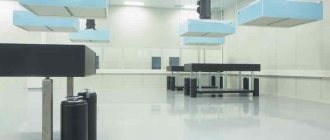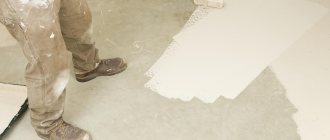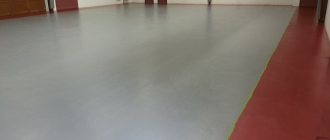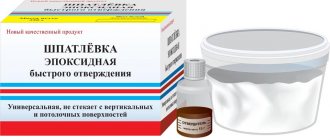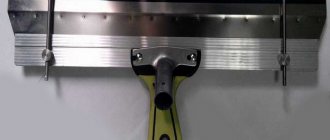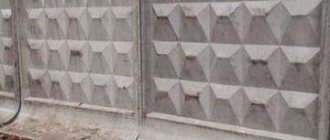Purpose
Epoxy impregnation is a polymer hardener that consists of molecules that penetrate the pores of the base and harden in it. It seems to stick to the floor. This material is non-toxic . It is used for:
- prevent corrosion;
- increasing resistance to chemicals;
- strengthening the base (abrasion resistance);
- increasing the service life of the floor;
- frost resistance;
- difficulties in the penetration of gases and liquids through floors;
- easier cleaning;
- preventing the raising of cement dust from the concrete floor;
- leveling the surface when pouring concrete mixture, etc.
Epoxy impregnation gives the concrete coating a varnishing effect. The additive is mainly used with water. This gives it the opportunity to penetrate into the concrete base and form a single solid mass with it. The shelf life of the impurity is short (about six months).
Return to contents
Types of epoxy primer for concrete
Epoxy mortars for concrete are graded into two main types:
One-component mixture
One-component solutions can be used on various types of surfaces, including substrates with poor absorption. There will be no hassle in preparing them for work: the soil is sold ready-made and you only need to mix it before processing the base.
Two-component mixture
Two-component epoxy primers are most often used for priming concrete surfaces on which it is planned to later make self-leveling floors. Before work, the primer will need to be prepared by mixing two components: a base base and a hardener.
Technology of use
Preparing the epoxy floor base. Before starting work, it is necessary to remove the top layer of concrete, the iron layer, and clean the surface using a grinding machine or brushes. This must be done so that the pores in the concrete open as much as possible to absorb the additive:
- Material preparation: Grunt-2K/100 – 2:1.
- Putty-2K – 6:1 (y).
Mix the primer for several minutes (2-3 is enough) - begin to slowly mix in the putty using direct and reverse rotation technology - let stand for up to 5 minutes (to get rid of excess air). To work, you need to take a mixer with a power of 500-1000 rpm.
Return to contents
Why do you need to apply a primer under a self-leveling floor?
The primer composition is a material that is required for application both under any paint and under self-leveling floors. At first glance, an optional step contributes to the performance of important functions:
- protects the base from the penetration of moisture from the covering - creates a barrier to the occurrence of mold, mildew and overuse of the top material;
- fills pores and small cracks in concrete, making it smooth and convenient for distributing the polymer mixture - speeds up work;
- fastens unstable areas in cement, protecting the surface from chipping, deformation, and cracking;
- improves the adhesion of the floor covering to the base, prevents peeling and the formation of voids with air;
- increases the resistance of the polymer coating to impacts and other influences;
- protects the top layer from cracking and makes drying more uniform.
A properly processed concrete slab produces dust even after being treated with a construction vacuum cleaner. Primer eliminates this drawback, making the surface ideal for finishing. The material must be applied both under a new concrete screed and under self-leveling floors - this stage is mandatory in construction technology.
Coating
On large areas it is more convenient to apply impregnation with a roller.
Remove dust and immediately apply the material using the “crosswise” technology. Make sure that the mixture does not collect in puddles; poorly covered areas can be worked on additionally. If there is a need for puttying, it must be done immediately after priming and then cleaned of stains from the spatula. Next, you need to apply a finish (a transparent glossy layer).
Despite the fact that the additive is non-toxic, safety precautions must be observed when working with it. Impregnation should be carried out in cotton suits, gloves, etc. The tools used to apply the impurity (brushes, rollers) are not suitable for the next use.
Return to contents
Topping: this is a modern way of strengthening a concrete base
Hardening topping – what is it? The first step is to learn more about this protective coating. This concrete hardener is represented by a durable outer surface, which includes cement, plasticizing additives, fixers and dyes. The first element acts as a connecting link between the fillers, preventing the material from peeling off.
The remaining ingredients give the coating wear resistance, impact resistance, crack resistance, resistance to aggressive chemical environments, frost resistance, hygiene, reflective, antistatic and decorative qualities.
The topping is available in liquid and dry form. The first option contains inorganic compounds that are highly soluble in water. When applying the mixture to the floor covering, the composition penetrates into the pores of the concrete, forming durable sealants that are resistant to moisture. Dry topping is in a powdery state. The composition is scattered onto the surface in the form of small crumbs, followed by compaction and grinding. This option is characterized by lower cost.
Thanks to the topping, the wear resistance of the surface increases several times.
Note! The use of dry material involves the formation of seams on the surface.
Benefits of use
Epoxy impregnation:
- does not require much time - applied to fresh concrete;
- no additional waterproofing is required - the additive is vapor permeable;
- dries up to 6 hours, completely hardens after 7 days - the work does not take longer;
- economical to use;
- odorless - can be used both in warehouses and in residential premises and hospitals;
- does not require special skills to use, so it is accessible to everyone.
Return to contents
We will make budget protection from 800 rubles/m2 - time does not beat, but kills your defenseless floors
concrete flooring cannot fail to impress
Floor impregnation as a way to dramatically improve the quality of concrete floors
Our phone number has not changed for many years, you can always contact us!
Get advice from a leading specialist and calculate the cost of the floor
+7(499) 398-02-36, +7(926) 225-16-81, whatsApp +7(916) 087-31-88, E-mail
Characteristics of epoxy impregnations
Technical characteristics of the additive:
- Mixes with the base in a ratio of 100:13.
- Colorless, transparent liquid.
- Consumption 200-300 grams per m2.
- Consumption time for 100 g of material at 200C is 25 minutes.
- Adhesion after 28 days – at least 1.5 N/mm² (B1.5).
- Use at temperatures 100C.. 200C.
- Brand strength from M200.
- Base humidity up to 4%.
- Air humidity up to 80%.
- Impregnation is applied to concrete 28 days after it is laid.
Return to contents
How to choose a primer for floors?
A special type of soil is used for the flooring - this is written on the packaging. Types offered by building materials trading companies:
- quick-drying – used as an express option for finishing work, easy to apply, quickly saturates concrete and dries in a short time;
- standard - suitable for application under self-leveling mixtures based on polyurethane and epoxy, used for finishing residential and commercial premises with heating;
- winter - used to form coatings that will be used at temperatures down to zero degrees;
- anti-corrosion – has increased protection against moisture penetration, recommended for rooms with high humidity.
The material is selected depending on the purpose of the room, the level of load on the floors and temperature conditions.
Examples of manufacturers
Elakor-ED
The Elakor-ED series includes epoxy primer with solvent (primer - 2K/60) and without (primer - 2K/100), epoxy paint (enamel 2K), epoxy transparent light-resistant varnish (varnish-2K), epoxy self-leveling floor, as well as Self-leveling floor G1, White Extra, transparent (for rear floors), antistatic, epoxy putty-2K, tricsotropic epoxy compound. When using Elakor-ED, you must follow the following safety precautions:
- Gas respirators (grade A) or gas masks.
- If work is carried out in enclosed spaces, it is necessary to use a hose gas mask or flow-exhaust ventilation.
Elakor-ED is a fire hazardous additive. The resin must be allowed to dry. Until the admixture has hardened, you should avoid open flames or tools that could cause a spark.
Return to contents
BAUPOX 100 GP
A two-part, deep-penetrating, colorless mixture based on epoxy resins. It is used to add strength to the concrete base, and also as an anti-dust agent for concrete floors. Properties of epoxy impregnation:
- easy to use;
- slight stickiness;
- deeply acting.
Characteristics:
- used with concrete, class C20/25;
- the foundation must be stable;
- minimum adhesion 1.5 N/mm2;
- base moisture content up to 4%;
- the surface must be sealed;
- surface temperature from 100C;
- air humidity up to 75%.
The material consists of two parts: resin and hardener, which must be mixed in the proportions required for work using a low-speed drill. Apply using a roller or brush. If impregnation coating occurs in an inappropriate humidity and temperature environment, it is necessary to use heating devices or dehumidifiers.
Return to contents
Epoxol
Epoxol is an impregnation for concrete floors and screeds.
A two-component material based on water. Purposes of use:
- Gives strength (2-3 times) and removes dust from the base.
- Gives the surface resistance to chemicals, water, etc.
- Corrosion protection.
The impregnation is environmentally friendly, applied to fresh concrete or old (wet) concrete. If the impregnation is used on fresh concrete, it enhances water resistance, frost resistance, and corrosion resistance. Preparation: the resin is mixed with the hardener until smooth, water is added (8-10 liters per 1 kg of solution). Before use, let the mixture stand for 10 minutes. Should be applied to a cleaned base.
Return to contents
Other
Epoxy impregnations from other manufacturers that are used for concrete bases:
- epoxy impregnations for special purposes: EHD, EA;
- epoxy-modified impregnations of the EPOFOM brand (epoxy compound for the installation of self-leveling floors, coatings, repair of pipelines) Epof-1,2,3, Epof - 1s;
- epoxy-diane impregnations for paintwork materials E-41, E-40, E-40r.
Return to contents
Application of epoxy resin: rules and recommendations
Before applying the material, the surface to be treated must be cleaned with a grinding machine.
When mixing the components in the impregnation composition, take into account that the mixture will harden after 30 minutes, as a chemical reaction will occur with the release of heat. Therefore, the prepared solution must be poured onto the cleaned concrete surface with a grinding machine or brushes. The top layer dries in 16 to 24 hours. The epoxy primer is applied in layers on top of each other until it becomes completely glossy. It is used for interior and exterior work, as a finishing or intermediate layer.
The higher the grade of concrete (M300 and higher), the lower the primer consumption and the better the efficiency. It is unacceptable to reduce the consumption of impregnating compounds for the sake of savings. To accurately determine the amount of material, a trial treatment of a small area is carried out.
Epoxy impregnation is widely used for concrete floors. The material is environmentally friendly. During construction and repair work, the coating costs minimal costs and looks like varnished concrete. The impregnation does not peel off, provides dust removal and resistance to surface damage.
Conclusion
Epoxy impregnations are not a new, but widely used type of material. They are based on epoxy resins, which are mixed with a hardener in the required proportions. These impregnations are non-toxic, but safety precautions must be observed when working with them. They are used not only for concrete, but also for other materials.
Epoxy resin in liquid form is a fire hazardous material. This material is used to give concrete strength and dust resistance. When using such a material, it is necessary to take into account the manufacturers' requirements regarding the humidity of the coating, air, ambient temperature and substrate.
The problem of dusty floors
A concrete floor has a disadvantage: its top layer has less strength and is therefore susceptible to abrasion.
This is due to the fact that during the hardening process of concrete, the so-called “cement laitance” appears on its surface. As it hardens, it forms a looser, more porous layer that is susceptible to abrasion.
As a result of abrasion, dust appears. It would seem that this is a trifle, but in fact, floor dust becomes the source of many problems:
- Dust is harmful to human health.
- Dust has a negative impact on equipment and devices, reducing their service life, and this can be a serious blow to the budget.
- Cleaning is difficult.
- The coating on top of the dusty floor will creak.
- The upper weak layer also weakens the concrete in deeper layers, contributing to its gradual destruction.
Important!
Unprotected concrete can deteriorate to a depth of 1-2 mm per year.
Thus, dusty floors are not as harmless as they might seem. And it’s better to prevent it than to change the floor and buy new equipment.
Technologies for applying topping to floors
There are several technologies for floor topping. The DTW method involves applying a dry hardener to the wet concrete base, which can be spread by hand or using special carts. Such mechanisms ensure uniform coverage of a large surface area with powder. The concrete base dries and sets together with the topping, which ensures high adhesion.
After the surface has completely dried, the absorbed mixture is rubbed down using a special grinding machine. This coating is reliable, durable, resistant to various adverse factors and durable.
After the concrete has dried, the saturated mixture is rubbed using a special trowel.
WTW technology involves applying a liquid topping immediately after laying the concrete floor. This option for laying the hardener has been used recently and is not yet recognized as popular, since the application process is quite complex, labor-intensive and expensive. However, this coating is characterized by maximum strength and high decorativeness. The surface is perfectly flat, smooth, evenly colored and beautiful.
The WTD method involves the use of dry topping, which is laid on a wet or dry screed. The final stage of the work is thorough grouting of the surface.
There is a volumetric option for applying topping, which ensures the strengthening of the concrete surface throughout its entire thickness. At the stage of pouring concrete floors, a special plasticizer is mixed into the working solution, which improves the performance of the surface.
Note! The volumetric method of applying topping involves the use of a grade of concrete for screed not lower than 350 for the concrete base.
The WTW method of application involves the use of a liquid topping, which is applied to wet concrete.
Areas of use of topping floor
This technology for strengthening concrete bases is used in warehouses, industrial and production workshops. Due to their hygiene, such floors are indispensable in the food industry. Due to their frost resistance, topped concrete floors are the best solution for refrigerators and freezers. The presence of reflective qualities ensures the demand for the hardener on objects with elevated temperatures.
High wear-resistant qualities make the protective coating indispensable in places with increased vibration and mechanical load, such as parking lots, shopping and entertainment complexes, medical, cultural and educational institutions, and pedestrian areas with high traffic. This industrial floor screed is widely used in car dealerships, car service centers, hangars, garages, where the top concrete coating is constantly in contact with gasoline and diesel fuel, slightly alkaline liquids and mineral oils.
Note! Topping cannot be used for rooms where acids and alkalis are widely used, for which special impregnations are acceptable.
Topping floors, due to their hygiene, are indispensable in dining rooms.
Topping helps to increase the service life of floors in gyms, sports fields and swimming pools. The coating today is widely used on civil objects, which is associated with low maintenance, durability and decorativeness of the surface when using colored compounds.

